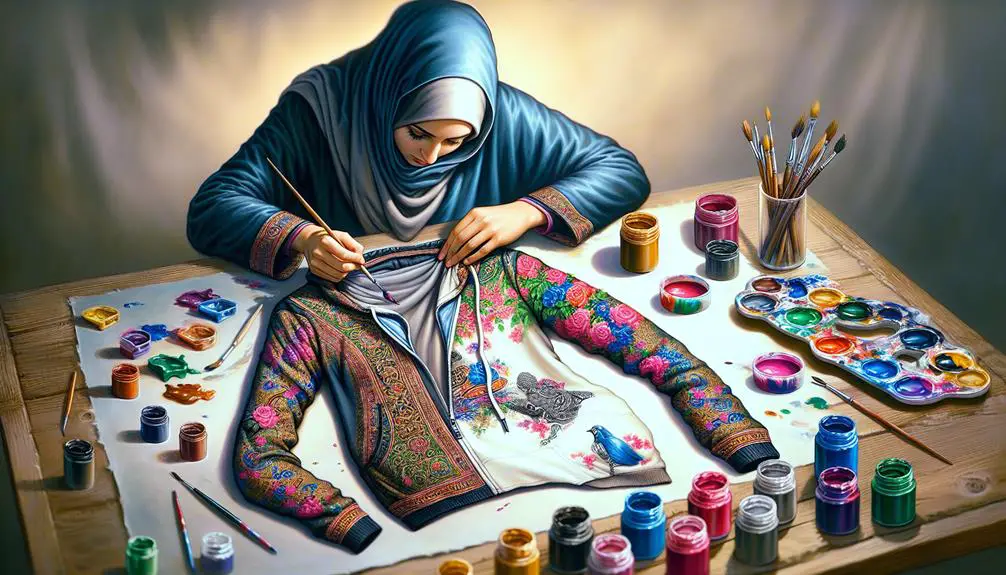As I dipped my paintbrush into a pool of vibrant colors, I couldn't help but feel a surge of creativity flowing through me. The blank canvas of a hoodie before me held endless possibilities, each stroke adding personality and flair.
But how does one approach this seemingly simple yet intricate task of transforming a basic garment into a unique piece of wearable art? Join me as I unravel the secrets behind painting a hoodie, from choosing the right materials to mastering hand-painting techniques that will set your design apart.
Table of Contents
Key Takeaways
- Choose high-quality fabric paint for vibrant colors and lasting results.
- Plan design carefully to reflect personal style and trends.
- Experiment with painting techniques like stenciling and blending colors.
- Seal and maintain painted hoodie for longevity and durability.
Setting up Your Workspace
To set up my workspace for painting a hoodie, I washed and dried the hoodie on the highest heat setting to pre-shrink it and get it ready for painting. Once the hoodie was prepped, I slid a piece of cardboard inside to keep it flat and provide a smooth painting surface. Covering my work surface with a drop cloth was important to protect it from any potential paint spills or splatters during the painting process.
Using fabric paint specifically designed for textiles, I made sure to achieve vibrant and long-lasting colors on my hoodie. A quality brush set was essential for applying the paint smoothly and with precision. I made sure to select cotton hoodies as they offer the ideal surface for fabric paint to adhere to effectively.
With the workspace properly set up, including adequate ventilation to prevent any issues with paint fumes, I was ready to apply paint to my hoodie, knowing it would dry without cracking and result in a professional-looking finish.
Choosing the Right Materials
After setting up my workspace for painting a hoodie, the next step is selecting the right materials to guarantee a successful and vibrant outcome. When picking materials, make sure to choose a white cotton hoodie as the base for better paint adherence and vibrant colors. Make certain you use fabric paint specifically designed for textiles to prevent cracking and fading over time. Additionally, consider incorporating fabric markers or spray paint for different painting techniques and effects. To achieve precise and detailed painting, invest in high-quality brushes in various sizes. Before starting the painting process, prioritize fabric preparation by washing and drying the hoodie without fabric softener; this will help the paint adhere better to the fabric. To summarize, the table below provides a quick reference guide for selecting the essential materials for painting a hoodie:
| Material | Importance | Recommendation |
|---|---|---|
| White Cotton Hoodie | Better paint adherence and vibrant colors | Opt for a white cotton hoodie |
| Fabric Paint | Prevents cracking and fading | Choose fabric paint for textiles |
| Fabric Softener | Avoid use for better paint adhesion | Skip fabric softener during fabric preparation |
Planning Your Design
When planning my hoodie design, I start by choosing a concept that resonates with me.
I sketch out my initial ideas to see how they'll look visually.
Next, I select a color palette that complements both the hoodie and my personal style.
Choose Design Concept
Considering the hoodie color and fabric texture is crucial when planning the design concept for painting. To make sure a successful design, I must research popular hoodie painting trends for inspiration and guidance.
Sketching out my design concept on paper before transferring it to the hoodie will help me visualize the final product. Additionally, I need to take into account the size and placement of my design to guarantee it fits well on the hoodie.
Sketch Initial Ideas
To sketch initial ideas for my hoodie painting design, I will start by putting pencil to paper to visualize the layout and details. It's important to contemplate the placement of design elements on different parts of the hoodie, such as the front, back, sleeves, and hood. This helps in creating a cohesive and visually appealing overall look. When sketching, I will explore various styles, themes, and motifs that resonate with my personal taste and creativity. Experimenting with different drawing techniques like shading, stippling, and hatching can enhance the depth and dimension of the design. Reference images or mood boards can provide inspiration and aid in refining initial ideas before transferring them onto the hoodie.
| Design Elements | Drawing Techniques |
|---|---|
| Front | Shading |
| Back | Stippling |
| Sleeves | Hatching |
| Hood | Sketching |
Select Color Palette
As I progress in my hoodie painting project, the next step involves selecting a color palette that complements the hoodie's base color and aligns with my design vision. When choosing the color palette for painting a hoodie, it's crucial to take into account the following:
- Take into account the hoodie color: Choose colors that work well with the base color of the hoodie.
- Color theory principles: Explore contrasting or analogous colors for a harmonious design.
- Plan color distribution: Create balance and visual interest by strategically distributing colors.
- Mood and message: Select colors that convey the intended mood or message of the design.
Remember to experiment with different shades and tones to make sure the final color palette enhances your hoodie painting project.
Hand-Painting Techniques
When hand-painting a hoodie, utilize fabric paint on an artist's palette for intricate designs. Before starting, make sure the hoodie has been washed and dried to create a clean canvas for your artwork.
Fabric paint is ideal for this project as it adheres well to fabric fibers and maintains its vibrancy after drying. Mixing colors on the palette allows you to create a wide range of shades and tones, adding depth and dimension to your design.
To maintain precision, sketching your design with chalk beforehand can help guide your hand as you paint. Using a variety of brush sizes from different brush sets enables you to achieve various brush strokes and intricate details in your artwork.
Experiment with different hand-painting techniques such as stenciling or freehand painting to enhance the creativity and uniqueness of your hoodie design.
Stenciling for Precision
For precise and intricate designs on your hoodie, consider utilizing stenciling techniques. Stenciling allows for clean and sharp lettering, shapes, and patterns, ensuring a professional look.
To achieve mastery in stenciling for precision, follow these key tips:
- Use Freezer Paper Stencils: Opt for freezer paper stencils for their ability to create detailed designs with clean edges.
- Maintain Consistency: Stencils help promote that the paint stays within the designated areas, providing an even coat throughout the design.
- Secure Stencils Firmly: Prevent paint seepage and smudging by securely fastening the stencil to the hoodie before painting.
- Lift Stencils Carefully: After painting, lift the stencil gently to reveal crisp and detailed images on the fabric, showcasing your intricate design with precision.
Spray-Painting Tips
To achieve vibrant and long-lasting results when spray-painting a hoodie, make sure you use fabric spray paint designed specifically for this purpose. Using acrylic paint can lead to cracking and stiffness after drying, which isn't ideal for a flexible garment like a hoodie.
Before starting, shake the spray paint can thoroughly to guarantee a consistent and even spray pattern. When applying the paint, hold the can 6-8 inches away from the hoodie. This distance helps in achieving best coverage while preventing drips or pooling of paint.
Working in a well-ventilated area or outdoors to avoid inhaling fumes and allow for proper drying of the paint is crucial. Apply light, even coats of spray paint to build up color intensity gradually. This technique helps prevent oversaturation and running of the paint, resulting in a professional finish.
Caring for Your Masterpiece
After creating your masterpiece by spray-painting your hoodie, it's important to properly care for the artwork to secure its longevity and vibrancy. To make certain your painted hoodie stays in pristine condition, follow these expert care tips:
- Wash the hoodie inside out: When it's time to clean your painted hoodie, turn it inside out before washing. Use cold water to help preserve the design and prevent any fading that may occur.
- Avoid bleach and fabric softener: To sustain the vibrancy of the paint, refrain from using bleach or fabric softener during the washing process.
- Completely dry the hoodie: After washing, dry the hoodie on a low heat setting or opt for air drying. This will prevent any damage to the paint and fabric, guaranteeing your artwork stays intact.
- Iron inside out: To set the paint and guarantee the longevity of the design, iron the hoodie inside out. This step will help maintain the integrity of your painted masterpiece.
Frequently Asked Questions
Will Acrylic Paint Stay on a Hoodie?
Yes, acrylic paint can stick to a hoodie effectively when combined with fabric medium and heat-set properly. Without these steps, the paint may crack or peel over time. Following these techniques guarantees longevity and vibrancy in the design.
What Kind of Paint Do You Use on Clothing?
I use fabric paint for clothing. Mixing it with fabric medium enhances adherence. Fabric paint is flexible, washable, and durable on items like hoodies, ensuring longevity. Quality fabric paint offers vibrant colors and a professional finish.
How Do You Seal Acrylic Paint on a Hoodie?
To seal acrylic paint on a hoodie, I recommend heat-setting it with an iron on high heat for 2-3 minutes. Cover the design with a clean cloth, ensuring no direct contact to prevent smudging. This process helps make the paint more durable and wash-resistant.
Is Acrylic Paint Permanent on Fabric?
Yes, acrylic paint is permanent on fabric when heat-set correctly. It's important to use an iron to set the paint into the fabric fibers. Without heat-setting, acrylic paint may wash out or fade over time.
- Tetron Fabric for Marine Applications: Durability and Use Cases - June 18, 2025
- Tetron Fabric for Outdoor Furniture: Weather Resistance and Care - June 18, 2025
- Tetron Fabric for Wall Coverings: Style and Application Tips - June 18, 2025





